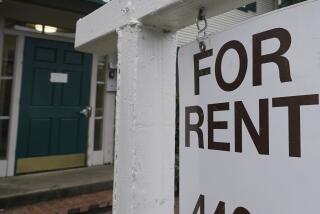Plan ahead to recoup full security deposit
- Share via
Security deposit use and abuse leads the list of causes of litigation between landlords and tenants.
How to avoid disputes? First, be aware that money can be deducted from a deposit. Basics include unpaid rent, cleaning and returning the premises to the condition in which it was first rented. The top deposit busters include:
* Rent. Most states require a tenant to give written notice to the landlord before taking off. In California, the required notice time is based on the days between rental payments, typically 30 days. Written notice is required to prevent misunderstandings about the rent owed and the date of departure.
Some tenants on leases assume that if their lease is up, they can simply leave. Not so fast, unless you want to leave some money behind. Unpaid rent is a common deposit deduction for forgetting to give notice 30 days’ worth of notice in California, and the landlord may keep the deposit if no written notice was provided. It doesn’t cost a thing to give written notice and save misunderstandings later.
* Extra rent. Slipping out early, or breaking a lease altogether, can cause the deposit to be forfeited for the amount equal to the rent due and then some. Until a suitable replacement tenant is found, you may be on the financial hook.
Not getting along with your roommate? You’ll need to pitch in your share of the rent until another person takes your spot.
* Cleaning. Often a tidy sum is kept by landlords for cleaning. “But it wasn’t clean when I moved in,” some tenants lament at move-out, according to Jim Silton of Silton Management in Westwood. “If it isn’t clean, be sure to complain at move-in. At move-out, it’s too late.”
If units are not cleaned to a level on par with the move-in condition, the deposit may be used to mop up the mess.
What type of cleaning? Here, it gets tricky. Some landlords consider clean just removing your worldly possessions, while others expect the carpet shampooed and the grout scrubbed with a toothbrush and bleach.
To help define the level at move-in, before and after photos are a good idea. Ask for a cleaning checklist from the landlord if you wish to tackle the task yourself at move-out.
* Restoring to original condition. Hotly contested by both landlord and tenant, “condition as when first rented” is a term frequently used in leases but often not documented.
Since this area can result in a deposit deduction, protect yourself with lots of photographs or a video of the move-in condition. Some states, among them Arizona and Washington, require that a move-in inspection checklist be given to new tenants. Others, including California, have only a move-out inspection requirement. No matter what the law, document now or defend later.
* Damage. Think of damage as injury to the premises. Often a spontaneous event, damage can range from a broken window to a torn rug. The longer you leased an apartment, the more wear and tear is expected, especially for carpets and paint.
* Excessive wear and tear charges. If you rented a car and dented the fender, that would be damage. But what if you rented a car for a year? You might expect the tires to be worn but not to be ruined by a spike strip. Visualize the same standard for a rental. Once again, an inventory walk-through with photographic backup should keep the record straight.
* Missing items. If the unit was rented with towel racks, for example, return it with the same towel racks. Fixtures, which means anything attached, cannot be removed unless the landlord granted permission in writing.
Being warned of deposit deductions is now part of state law in California, Florida, Georgia and Tennessee, to name a few. The warning includes a mandatory notice to tenants by the landlord of the option of doing a pre-move-out inspection.
An itemized checklist, useful at the start and end of a tenancy, is available from many sources, including the California Department of Consumer Affairs at www.dca.ca.gov/legal/landlordbook/checklist.pdf.
Probably the best protection against unfair deductions is a walk-through inspection before moving out. It allows both landlord and tenant to get an idea of potential security deposit deductions ahead of time.
H. May Spitz is a Los Angeles-based freelance writer. Reader comments may be sent to hmayspitz@aol.com.
More to Read
Sign up for Essential California
The most important California stories and recommendations in your inbox every morning.
You may occasionally receive promotional content from the Los Angeles Times.






